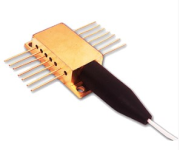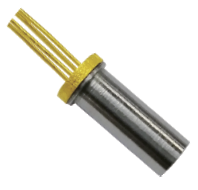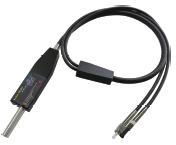
Commonly used in chemistry to provide a fingerprint by which molecules can be identified, Raman Spectroscopy is a spectroscopic technique used to observe vibrational, rotational, and other low-frequency modes in a system. It relies on inelastic or Raman scattering of monochromatic light, usually from a laser in the visible, near infrared, or near ultraviolet range. The laser light interacts with molecular vibrations, phonons or other excitations in the system, resulting in the energy of the laser photons being shifted up or down. The shift in energy gives information about the vibrational modes in the system. Infrared spectroscopy yields similar, but complementary, information.
Electro Optical Components has a variety of laser diode modules specifically for Raman Spectroscopy.
The 785, 808, 830 and 1064 nm lasers are narrow bandwidth for precision in the Raman Spectroscopy process.
One package combines the 785 and 1064 nm lasers so you can switch to the one that suits your application the best.
All lasers (leaded package) require a driver, but many users have or want to design their own driver. If you need a driver for the laser (not laser system) let us know and we will include this.
Narrow Line Width Laser Diode Modules and Systems for Raman Spectroscopy
| Wavelengths nm | ± CWL | Output Power | Package | Part Number | Line Width | Feature |
|---|---|---|---|---|---|---|
| 785 | 0.5nm | 600mW | Leaded | R785±-0.5-600mWF-14SBTF-TG | <0.1nm | |
| 785 | 0.5nm | 600mW | Leaded | R785±-0.5-600mWW-14SBTF-TG | <0.1nm | |
| 785 | 0.5nm | 500 mW | Small Module | NLSO-785-IMW-500 | <0.1nm | Free Space Module |
| 785 | 0.5nm | 500mW | Module | NLO-785-IMF(W)-500 | <0.1nm | FS & FC Module |
| 808 | 0.3nm | 600mW | Butterfly w Fiber Pigtail | R808±0.5-600mWF-14SBTF-TG | <0.3nm | FC Module |
| 830 | 0.5nm | 600mW | Leaded | R830±-0.5-600mWF-14SBTF-TG | <0.1nm | |
| 830 | 0.5nm | 500mW | Small Module | NLSO-830-IMW-500 | <0.1nm | Free Space Module |
| 830 | 0.5nm | 500mW | Module | NLO-830-IMF(W)-500 | <0.1nm | FS & FC Module |
| 1064 | 0.5nm | 600mW | Leaded | R1064±-0.5-600mWF-14SBTF-TG | <0.1nm | |
| 1064 | 0.5nm | 500mW | Small Module | NLSO-1064-IMW-500 | <0.1nm | Free Space Module |
| 1064 | 0.5nm | 500mW | Module | NLO-1064-IMF(W)-500 | <0.1nm | FS & FC Module |
| 785, 830, 976 or 1064 | 0.5nm | 500mw* | Module | NLO-XXX-IMF- | <0.1nm | |
| 785, 830, 976 or 1064 | 0.5nm | 500mw* | System | NLM-XXX-IMF | <0.1nm |
 Fiber Pigtailed Diode Laser Components delivering Stabilized Power Output
Fiber Pigtailed Diode Laser Components delivering Stabilized Power Output
14SBTF Fiber Pigtailed Diode Laser Components, are featured products of Electro Optical Components’ NL product line, utilizing wavelength-locking technique with volume Bragging gratings (VBG) and TE cooling, delivering stabilized power output, high Side-Mode Suppression Ratio, low temperature dependence of the lasing wavelength and various wavelengths.
Dual Wavelength Laser Diode Modules and Systems for Raman Spectroscopy
| Wavelengths nm | ± CWL | Output Power | Package | Part Number | Line Width |
|---|---|---|---|---|---|
| 784 & 785 | 0.5nm | 500 mW | Module | NLO-784/785-IMF(F)-500/500 | <0.1nm |
| 784 & 785 | 0.5nm | 500mW | System | NLM-784/785-IMF | <0.1nm |
| 785 & 830 | 0.5nm | 500mW | Module | NLO-785/830-IMF(F)-500/500 | <0.1nm |
| 785 & 830 | 0.5nm | 500mW | System | NLM-785/830-IMF | <0.1nm |
| 785 & 1064 | 0.5nm | 500mW | Module | NLO-784/1064-IMF(F)-500/500 | <0.1nm |
| 785 & 1064 | 0.5nm | 500mW | System | NLM-785/1064-IMF | <0.1nm |
| 785 & 1064 | 0.5nm | 600mW | Leaded | R785/1064±-0.5-600mWF-R2G-TG | <0.1nm |
Compact Raman Laser – Wavelength Stabilized
Electro Optical Component’s Compact Raman Laser offers the same narrow spectral width and wavelength stabilization as the bigger modules, but they are much smaller for Raman applications where size is an issue.
| Wavelengths nm | ± CWL | Output Power | Package | Part Number | Line Width |
|---|---|---|---|---|---|
| 785 | 0.5nm | 100mW | Compact | R785±0.5-100mWW-04BCK-S-G | 0.1nm |

Raman Probes
Electro Optical Component’s Raman Probes feature excellent coupling efficiency, wide spectral range, good stability, and can be used for laboratory applications, field measurements, etc.
| Model No. | Type | Probe Size mm |
|---|---|---|
| RL-RP -532, 785, 830 or 1064-F | Pigtail | 107x30x13 |
| RL-RP -532, 785, 830 or 1064-S | Free Space | 70x30x13 |

Raman spectroscopy is a spectroscopic technique used to observe vibrational, rotational, and other low frequency modes in a system. Raman spectroscopy is commonly used in chemistry to provide a fingerprint by which molecules can be identified. It relies on inelastic scattering, or Raman scattering, of monochromatic light, usually from a laser in the visible, near infrared, or near ultraviolet range. The laser light interacts with molecular vibrations, phonons or other excitations in the system, resulting in the energy of the laser photons being shifted up or down. The shift in energy gives information about the vibrational modes in the system. Infrared spectroscopy yields similar, but complementary, information.
Laser for Raman spectroscopy, particle size analyzer, and medical applications
 14SBTF Fiber Pigtailed Diode Laser Components are featured products of Electro Optical Components’ NL product line, utilizing wavelength-locking technique with volume Bragging gratings (VBG) and TE cooling, delivering stabilized power output, high Side-Mode Suppression Ratio, low temperature dependence of the lasing wavelength and various wavelengths. They are available in the following configurations:
14SBTF Fiber Pigtailed Diode Laser Components are featured products of Electro Optical Components’ NL product line, utilizing wavelength-locking technique with volume Bragging gratings (VBG) and TE cooling, delivering stabilized power output, high Side-Mode Suppression Ratio, low temperature dependence of the lasing wavelength and various wavelengths. They are available in the following configurations:
- 14SBTF Pigtailed Laser in a Pigtailed Butterfly Package
- NLM 14SBTF Laser Module
- NLMO 14SBTF Laser System
The R808±0.5-600mWF-14SBTF-TG Fiber Pigtailed Lasers from Electro Optical Components is a Fiber Pigtailed Laser Diode that operates at a center wavelength of 808 nm. It delivers a continuous wave output power of 600 mW and has a slope efficiency of 0.9 W/A. This narrow linewidth laser diode has a wavelength tolerance of ± 0.5 nm and spectral width of up to 0.3 nm. It has a temperature drift of 0.01 nm/°C (wavelength) and 0.05 nm/A (current).
The R808±0.5-600mWF-14SBTF-TG requires a threshold current of 0.3 A, DC voltage of 2 V, and consumes 1.2 A of current. It has an internal TEC, a thermistor, and photodiode. This laser diode has an optical fiber with a numerical aperture of 0.22 that supports FC/APC and SMA905 connectors. It is available in a hermetically sealed 14-pin Butterfly package and is ideal for Raman spectroscopy, up conversion material, particle size analyzer, and medical applications.
